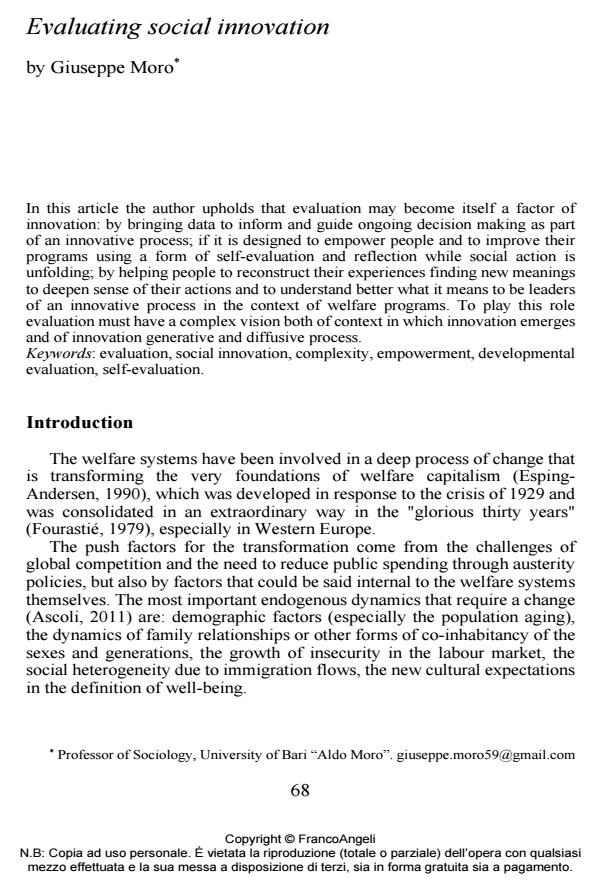Evaluating social innovation
Titolo Rivista SALUTE E SOCIETÀ
Autori/Curatori Giuseppe Moro
Anno di pubblicazione 2015 Fascicolo 2015/1EN Lingua Inglese
Numero pagine 11 P. 68-78 Dimensione file 57 KB
DOI 10.3280/SES2015-001006EN
Il DOI è il codice a barre della proprietà intellettuale: per saperne di più
clicca qui
Qui sotto puoi vedere in anteprima la prima pagina di questo articolo.
Se questo articolo ti interessa, lo puoi acquistare (e scaricare in formato pdf) seguendo le facili indicazioni per acquistare il download credit. Acquista Download Credits per scaricare questo Articolo in formato PDF

FrancoAngeli è membro della Publishers International Linking Association, Inc (PILA)associazione indipendente e non profit per facilitare (attraverso i servizi tecnologici implementati da CrossRef.org) l’accesso degli studiosi ai contenuti digitali nelle pubblicazioni professionali e scientifiche
In this article the author upholds that evaluation may become itself a factor of innovation: by bringing data to inform and guide ongoing decision making as part of an innovative process; if it is designed to empower people and to improve their programs using a form of self-evaluation and reflection while social action is unfolding; by helping people to reconstruct their experiences finding new meanings to deepen sense of their actions and to understand better what it means to be leaders of an innovative process in the context of welfare programs. To play this role evaluation must have a complex vision both of context in which innovation emerges and of innovation generative and diffusive process.
Keywords:Evaluation, social innovation, complexity, empowerment, developmental evaluation, self-evaluation.
- Argyris C., Schon D. (1978). Organizational Learning: a Theory of Action Perspective. Reading (Ma.): Addison & Wesley.
- Ascoli U., ed., (2011). Il Welfare in Italia. Bologna: Il Mulino.
- Barbera F. (2004). Meccanismi sociali. Elementi di sociologia analitica. Bologna: Il Mulino.
- Boudon R. (1977). Effets pervers et ordre social. Paris: Presses Universitaires de France (It. trans: Effetti “perversi” dell’azione sociale. Milano: Feltrinelli, 1981).
- Bourdieu P. (1980). Le sense pratique. Paris: Le Editions de Minuit (It. trans: Il senso pratico. Roma: Armando, 2005).
- Cresson E., Bangemann M. (1995). Green Paper on Innovation. European Commission.
- Dahler-Larsen P. (2009). Learning-Oriented Educational Evaluation in Contemporary Society. In: Ryan K.E., Cousins J.B, eds., The SAGE International Handbook of Educational Evaluation. Thousand Oaks (Ca.): Sage.
- De Ambrogio U. (2003). Valutazione e forme di coinvolgimento e partecipazione. In: De Ambrogio U., ed., Valutare gli interventi e le politiche sociali. Roma: Carocci.
- Donati P. (2001). Il lavoro che emerge. Prospettive del lavoro come relazione sociale in una economia dopo-moderna. Torino: Bollati Boringhieri.
- Esping-Andersen G. (1990). The Three Worlds of Welfare Capitalism. Cambridge: Polity.
- Fetterman D.M., Kaftarian S.J., Wandersman A., eds., (1996). Empowerment Evaluation. Knowledge and Tools for Self-Assessment & Accountability.
- Thousands Oaks (Ca.): Sage. Foresti M. (2003). La partecipazione in ambito valutativo: mito o realtà? Teoria e pratica degli approcci partecipati in valutazione. Rassegna Italiana di Valutazione, 25: 45-70. DOI: 10.1400/6648
- Fourastié J. (1979). Les trente glorieuses. Paris: Fayard.
- Giddens A. (2006). A social model for Europe? In: Giddens A., Diamond P., Liddle R., eds., Global Europe Social Europe. Cambridge: Polity.
- Merton R.K. (1936). The Unanticipated Consequences of Purposive Social Action. American Sociological Review, 6: 894-904. DOI: 10.2307/2084615.MulganG.(2014).SocialInnovation.Milano:Egea
- Niessen T.J.H., Abma T.A., Widdershoven G.A.M., van der Vleuten C.P.M. (2009).
- Learning-in-(Inter)action: A Dialogical turn to Evaluation and Learning. In: Ryan K.E., Cousins J.B., eds., The SAGE International Handbook of Educational Evaluation. Thousand Oaks (Ca.): Sage.
- Palumbo M. (2003). La valutazione partecipata e i suoi esiti. Rassegna Italiana di Valutazione, 25: 71-88. DOI: 10.1400/66482
- Palumbo M., Congiu D. (2009). Partecipazione e valutazione per il Piano Regolatore Sociale. In: Palumbo M., Torrigiani C., eds., La partecipazione fra ricerca e valutazione. Milano: FrancoAngeli.
- Patton M. Q. (2011). Developmental Evaluation. Applying Complexity Concepts to Enhance Innovation and Use. New York: The Guilford Press.
- Scriven M. (1973). The methodology of evaluation. In House E.R., ed., School Evaluation: the Politics and Process. Berkeley: McCuthan.
- Sen A.K. (1992). Inequality Re-examined. Oxford: Oxford University Press (It. trans.: La diseguaglianza. Un riesame critico. Bologna: Il Mulino, 2000).
- Torrigiani C. (2009). Partecipazione e valutazione partecipata. In: Palumbo M., Torrigiani C., eds., La partecipazione fra ricerca e valutazione. Milano: FrancoAngeli.
- Social Innovation and Entrepreneurship in the Fourth Sector Ana Filipa Silva, Luisa Carvalho, María Isabel Sánchez-Hernández, pp.255 (ISBN:978-3-030-75713-7)
Giuseppe Moro, Evaluating social innovation in "SALUTE E SOCIETÀ" 1EN/2015, pp 68-78, DOI: 10.3280/SES2015-001006EN